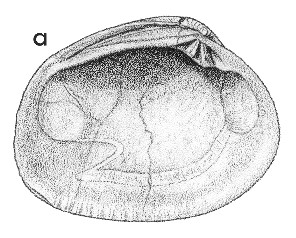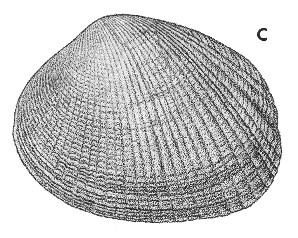
Revised descriptions of New Zealand Cenozoic Mollusca from Beu and Maxwell (1990)

 | Revised descriptions of New Zealand Cenozoic Mollusca from Beu and Maxwell (1990) | 
|
  (Pl. 46a): GS13734, W21/f49, basal shellbed of Maraetotara Sand, Cape Kidnappers, Hawke's Bay, Castlecliffian (GNS) |
  (Pl. 46c): GS13734, W21/f49, basal shellbed of Maraetotara Sand, Cape Kidnappers, Hawke's Bay, Castlecliffian (GNS) |
Beu & Maxwell (1990): Chapter 16; p. 344; pl. 46 a,c.
Synonymy: Venus costata Quoy & Gaimard 1835, p. 521 (not of Dillwyn, 1817); Venus crassicosta Deshayes 1835, p. 373; Chione costata; Tapes crassicosta; Paphia (Protothaca) crassicosta; Protothaca (Tuangia) crassicosta
Type species of Tuangia Marwick, 1927 (synonymised with Protothaca Dall, 1902 by Beu & Maxwell, 1990)
Classification: Veneridae: Chioninae
Description: Small for genus (35-45 mm long), elongate-ovate to subrectangular, solid, with finely serrate interior ventral margin. Dorsal and ventral margins weakly to quite strongly curved, subparallel; anterior and posterior margins lightly curved, converging towards dorsum; umbo at anterior quarter of length. External sculpture of many wide, closely spaced, prominent radial costae, wider over posterior third than elsewhere, crossed by many narrow commarginal ridges that are regular and moderately prominent over anterior third but weaker further back. Lunule very small, narrow, marked off by shallow groove. Hinge with 3 narrow cardinal teeth, only, in each valve; left posterior cardinal lamellar, fused to nymph; left median and right median and posterior teeth grooved. Adductor muscle scars moderately large, shallowly impressed; pallial sinus small, very narrow, slightly ascending.
Comparison: The characters used by Marwick (1927) to separate the subgenus Tuangia were considered by Beu & Maxwell (1990) to be merely of specific rank. Two venerids in New Zealand have sculpture of both radial and commarginal elements of more-or-less equal prominence, Austrovenus stutchburyi and Protothaca crassicosta. Of these, A. stutchburyi is evenly oval and many specimens are almost as tall as they are long, whereas P. crassicosta is subrectangular and antero-posteriorly elongate. Also, most specimens of P. crassicosta have the radial costae more prominent on the posterior end than on the anterior, whereas they are similar all over on A. stutchburyi.
Distribution: Opoitian-Recent; Recent, New Zealand (types of Venus costata and of Venus crassicosta); common in the modern fauna buried in sand and gravel in crevices on exposed rocky shores, low in the intertidal zone and just below, and so rare as a fossil. We know of one Opoitian record from the Ngamatea plateau, north of the Napier-Taihape Road, central North Island (Beu 2006, p. 289, fig. 35C), one from the early Castlecliffian of Cape Kidnappers (illustrated) and several from Haweran raised terrace faunules.
Cite this publication as: "A.G. Beu and J.I. Raine (2009). Revised
descriptions of New Zealand Cenozoic Mollusca from Beu and Maxwell (1990). GNS
Science miscellaneous series no. 27."
© GNS Science, 2009
ISBN
978-0-478-19705-1
ISSN 1177-2441
(Included with a PDF facsimile file
copy of New Zealand Geological Survey Paleontological Bulletin 58 in CD version
from: Publications Officer, GNS Science, P.O. Box 30368 Lower Hutt, New
Zealand)